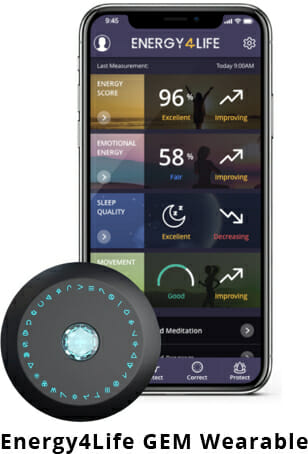A recent study by researchers at the University of California at San Diego, found that a bioenergetic wearable device delivering biological information to the body using photons, has positive effects on the physiology of live cell cultures. This study has found these results may lead to improved energy levels and sleep quality, reduce stress, and help people better manage their emotions.
A cutting-edge technology, developed and created by Energy4Life, bioenergetic wearable devices use digitized biological information to help restore the body’s energy.
“Our bioenergetic wearables are designed to communicate directly to the body, thus triggering its self-repair system,” said Harry Massey, founder and CEO of Energy4Life. “Digitized biological information allows you to help turn on the body’s self-repair system – impacting the physics of the body – which in turn directs all other activity of the body,” stated Massey.
“We are pleased to see Dr. Patel’s research begin to prove what we have witnessed in hundreds of thousands of patients. Ancient medical practices like traditional Chinese Medicine and acupuncture have long believed that many health conditions occur because of an energetic imbalance. We actually know the body does this because of the biological responses to electromagnetic fields, as well as light and sound, both shown to alter the expression of DNA,” explained Massey.
Some of the key findings from the study include:
- Mitochondrial density increased by up to 50%
- Mitochondria were protected from reactive oxygen species damage by up to 67%, thus reducing cellular oxidative stress
- Possible protection against certain viral infections.
“We know that mitochondria are the cell’s powerhouse, creating ATP – the energy that powers a cell and all its unique functions. This study reveals that bioenergetics could be the next healthcare breakthrough for those suffering from fatigue, autoimmune disorders, and other diseases of aging – a breakthrough desperately needed and deserved,” continued Massey.
To obtain quantifiable results on how the bioenergetic wearable impacts cellular physiology, researchers imprinted culture mediums with biological information and performed a battery of in vitro experiments using various types of cells, including cardiac muscle, skeletal muscle, neural stem cells, and lung epithelial cells. Researchers used several different types of biological information.
Information may be administered through a special preparation of mineralized water (“imprinted” with photons and magnetic fields), or imprinted directly into the body via electronic equipment. This equipment includes the NES Health miHealth device and the GEM wearable, a new device slated for release in late 2023 by Massey’s newest company, Energy4Life.
The wearable is based on proprietary technology and extensive research spanning more than 30-years in the field-based control system, and based in physics opposed to the chemical-based system that most modern medicine relies on.
Observations from this study are the first of its kind. More comprehensive observations are necessary to understand the mechanisms underlying these changes.
Further studies are being conducted on how the wearable may aid energy and emotional management, reduce stress, and improve sleep and energy. More here.

